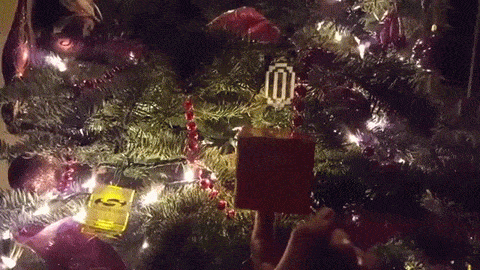[Jordan Wills] was tasked by his company, Silicon Labs, to build some Christmas Baubles to give away to co-workers. While the commissioned units were designed to be simple battery and LED affairs, he decided to make one of his own with bells and whistles. His Mario themed Christmas Ornament uses a Silicon Labs FM972 micro controller, capacitive sensing, PWM controlled 8 bit audio, and blinky lights.
The interesting part is some of the construction techniques that he used. The finger-joint style cube is built from circuit boards. Electrical connections between panels were routed using solder wicking copper braid. That’s a interesting trick which we’ll keep in mind along with some of our favorite creative structural uses of PCB.
The top of the cube has four LED’s which light up the Mario “Question Mark” symbols on the four sides of the cube while the base contains all of the electronics. The outside of the base piece was a large copper plane to act as the capacitive sensing element. This meant all electronics needed to be surface mounted with tracks laid out on one side – which posed some layout challenges. Adding the Capacitive sense function was a cinch thanks to support from the in-house design team. PWM output from the micro controller takes care of audio, and the output is routed through a buffer to boost the signal. A bandpass filter then cleans up the PWM output before feeding it to the speaker.
A nice trick was to clock the 24.5 MHz audio PWM at 22.1 KHz, the sampling frequency of the audio clips from the original NES Super Mario Brothers. On each interrupt, the next PWM value was loaded from memory into the register that controls the PWM active width. Since the microcontroller did not have enough memory, an EEPROM was added. [Wills] had to write some custom code to allow writing data to the EEPROM and create a file system to allow audio sample files to be retrieved from the memory.
Outside the cube, a laser cut acrylic “Coin” was attached. An LED lights it up and the speaker plays the coin sound when the cap sense plate is touched. Check out this photo album documenting his build, and the short video showing it in action.
















FFS! Really? You have to cram Arduino in the title?
Pretty sure that sentiment is exactly why they put Arduino in the title. I found it humorous.
Trollbaiting is part of the HaD employee benefits package. Great gig if you can get it.
10 cents per click.
2 bits for 3 clicks.
I don’t get it. Why do people still attack the arduino platform? Its an excellent system and its uber cheap. It has allowed a wider group of individuals in the door to a world that was once very shut off to only an elite group of hardware hackers. PIC was and still is an excellent alternative to the arduino and not a lot of people use it anymore. I could only assume its a cost issue.
It’s overpriced and doesn’t encourage its users to learn or understand, but just c&p code. Most archon on projects should get ported to raw AVR boards after development in Arduino.
Also, its pretty overused. Nowadays every “hack” is some basic Arduino project. It became boring.
So when I was in 7th grade, the Arduino Duemilanove was just coming out. You know what got me into the world of electronics and microcontrollers? The Arduino Duemilanove. It’s a great microcontroller to introduce young kids to all of this. Had the Arduino never existed, I’m sure myself and many others would not have pursued our current paths in life. Sure, it’s simplified and copypastaing is easy. But it’s still a great introduction. The curious people WILL move on to more advanced topics, but would not have even thought about it had it not been for Arduino.
Clones are dirt cheap. Nearly disposable.
Reinventing the wheel is overrated. the heat of the computer in my house in Phoenix late 1970s was unbelievable. Diodes and transistors…hand assembled z80 cmp… 8″ floppy …no thnx… Atmelmega328 instead of a rat’s nest,hell ya
I think most of the issue haders have is that an AVR can be quite powerful in contrast to its actual use in may projects, sometimes even just performing the duty of a wire or inverter gate.